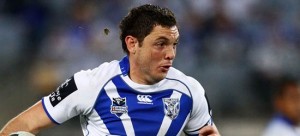
Then, fate smiled on the young team. Miraculously, they came up with the ball with less than a minute on the clock. The footy drifted wide, finding its way to 22-year-old Jonathan Wright, cutting back inside off the right wing. Darting infield, Jonathan spied a small gap in the Warriors’ defensive line, lunged forward and, reaching out with two hands, planted the footy just on the try line to seal a dramatic victory right on the full-time siren.
It was the type of play every kid dreams about when growing up – the ball and the game in their hands, scoring the winning play in the biggest game of the year. For Jonathan, it was a dream ending to one of the toughest years of his life.
“I couldn’t believe it,” he says, casting his mind back to those hectic few seconds. “It was just so frustrating because we’d basically dominated the whole game. I saw this little gap open up, and the closer I got to the line, the gap got smaller and smaller, but luckily I’ve got these big, long, gangly arms, so I reached out and got it. After that I couldn’t believe it, there was this grandstand in front of me that was full of Warriors fans – and they were dead silent.”
For Jonathan, the dramatic finish was even more significant given the year he and his family had just endured, a year in which they lost one of their young men, Jonathan’s older brother, Thomas Wright. As Jonathan celebrated his try, it was Thomas who was foremost in his mind.
It was back in August when Jonathan got the early morning call. At first, he feared some bad news about his father, and then came the news that set his world into a spin. His brother, a father of six children, had suffered a fatal heart attack at his home. He was only 36 years of age.
“It was a huge shock, for me and the whole family,” says Jonathan, reflecting on the difficult week, which by coincidence, happened to fall right on the NRL’s Close the Gap round, the league’s annual promotion of the national campaign to lessen the discrepancy between Indigenous and non-Indigenous mortality rates. Jonathan made up his mind to go ahead and play in the Close the Gap round as a tribute to his brother.
“I spoke to the family about playing against the Cowboys that weekend – Tom has always loved me and loved watching me play,” he says. “It was the Close the Gap round, which is about trying to teach our mob and everybody about closing the gap, and now Tom’s a statistic, which is sad for the family and also an eye opener – it was very sad, but we’re still celebrating his life.”
While he and his family went through a tough period, on the field Jonathan’s career in the NRL has gone from strength-to-strength. Originally from the Hunter region of Northern New South Wales, he played Jersey Flegg for the Newcastle Knights before linking with the Parramatta Eels where he played for feeder club Wentworthville in the NSW Cup Grand Final, before making his NRL debut in 2009. That year also saw him play in two finals’ matches as the Eels marched to the Grand Final.
After notching a further seven NRL games in 2010, a move across town to the Canterbury-Bankstown Bulldogs for the 2011 season proved to be the catalyst for Jonathan’s strongest year in top-flight footy to date – seeing the lanky centre playing in 11 NRL games, and the NSW Cup Grand Final.
“I enjoyed the year, it took a while to get there (playing NRL). I played a bit of NSW Cup to start the year and just stuck in there and got the nod and took the opportunity with both hands – I’ve really enjoyed it,” he says,
Perhaps a key to his on-field success in 2011 was the crop of talented emerging Indigenous players currently at the Bulldogs, including the likes of Joel Romelo, Michael Lett and co-leading 2011 try-scorer Ben Barba.
Jonathan says the Indigenous boys at the ’Dogs are a close group. He is very proud of his Aboriginality and has always had a strong love and sense of his culture, doing traditional dancing from an early age, performing at major events like the Sydney Dreaming and the Rugby Union’s World Cup. He was even accepted at the NAISDA dance college before focusing full-time on footy.
Jonathan is among the new crop of inspiring young Aboriginal footballers who view themselves foremost as role models to their community, and he approaches that role with a great deal of pride. The events of the past 12 months have only steeled his determination to provide a strong, positive example to young Indigenous Australians.
“Looking after your health by getting regular check-ups – that’s a massive message I want to help get out there,” he says.
“Always be safe, always check yourself and your health, and make sure of it, because you can think you’re bulletproof sometimes, and I don’t want anyone else to have this same experience.”
Comments are closed.